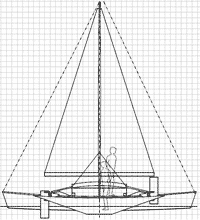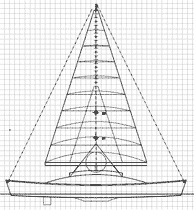|
If you happen to wake up some fine morning with an irresistible urge to waste an enormous amount of time, energy and mental effort on a totally trivial pursuit far from the mainstream, proa design has much to recommend it.
Having been so infected some time ago, WoodenBoat’s recent Design Challenge blew a little breeze over the embers and Nomad was the result. I had sent the preliminaries to our guru of the ezine, Chuck, to get some feedback before completing the design proposal when an innocent enough question of the proafile yahoo group pointed towards a possible solution to the one area I wasn’t really happy with in the design, namely the high stresses in the rig design.
I emailed Chuck to say never mind, I was going to shelve the design until I had the time to trial the new approach in a smaller (nonregistered) form. Chuck allowed as how it seemed a shame to let all that work go completely to waste and that I should let it be published in Duckworks.
Now that the deadline has passed for submittals to WoodenBoats Design Competition, here is the preliminary layout of Nomad. Please take it all with a grain of salt, if ever built, the rig will definitely be different and there are a multitude of little bits that are subject to change but it is still the approach I’d take for another trailerable boat for the Texas 200.
Introduction
Curse you Woodenboat! I had been in remission proa design wise for several months when I picked up the Dec issue (#217) of your magazine to peruse Tom Pamperins article on the Texas 200 (and see if it included any pictures of yours truly) and there lurking in the front of the magazine, the dreaded trigger phrase "Design Challenge". Come to think of it, my obsession with proas was initiated by the exquisite photo of Russ Brown's Kauri on the cover of WoodenBoat #83.
I resisted, really I did, but the thought kept creeping back "what would you do to make it better this time?". So enclosed please find my take on your Design Challenge III- Nomad. Nomad isn't likely to do well in the Design Challenge (being somewhat unconventional) but it is the trailerable boat I would build today for the Texas 200 if canoe sailing gets too strenuous for these old bones.
A serious attempt was made to do a more conventional design, three sheets long, Birdwatcher style cabin, twin balanced lugs, foils based on insights from Mik Storer, a nice boat to my eyes. But it wouldn't be as quick or as smooth a ride and could not begin to have the ghosting capabilities of the proa approach.
Brief When my first trailerable proa P52 hit the water in 2007 two things were immediately obvious; first the idea of keeping the overall length under 7 meters so as to not require running lights was disingenuous at best and second the boat really deserved to built out of better than $10/sheet underlay plywood. Other insights would come with time and miles. Among them:
The long lean dory style hull with a fairly high prismatic coefficient and flared sides made a superb open water boat.
Telescoping beams work better than swing arms. Solid slats work better than a trampoline.
General ergonomics are good; Chuck Leinweber claimed that it was the most comfortable small boat he had ever sailed on. Still, the boat needed a foot rest for sitting in the lower pod position.
It really is difficult to make a crab claw sail go downwind.
As much as I like steering oars, simple and versatile, they are not the best solution on a boat this size. This one came hard for me, I really liked the oars.
The extra weight (10 to 20#) of the ¾" T&G ply bottom is worth every ounce. This insight was reinforced one night as I listened to the bottom grind on the oyster shells underneath as the tide went out in a howling norther; too exhausted to stir and move the boat.
The pod/cabin structure would be just as happy lowered a bit to reduce windage and weight. The height of the original was dictated at least in part by the desire to keep the swing arm pivots separated. The berth flats would be better served with some small cross beams rather than a longitudinal girder support.
The loads on a staysail type system are stout, significant compression in the mast, tension in the stays to match even with a relatively wide staying base. Hence, there is no substitute for having the lowest stretch staying available. The float could use a little more buoyancy. On to the Details:
 |
Hull - Three full length two foot wide strips of ¼" plywood stitched and glued to a carefully shaped ¾" bottom, makes the hull. End bulkheads are moved out a bit and the cabin structure is a bit lower and shorter than Nomads predecessor. Earlier concerns about the "cavernous (claustrophobic)" nature of the berth spaces were unfounded with head out in the open end. Center cabin area is longer now and it was prudent to add a laminated frame to fix the relation between hull and cabin on the leeward side. A flat now extends across the hull at center of boat to brace hull near the waterline and provides a space to slide the requisite port-a-potti. In my boat port-a-potti would be replaced by the more traditional and versatile plastic bucket and judicious use of the new double bag disposal system. Berth flats which are an integral part of the hull framing are supported by multiple small cross beams.
Pod - Basic dimensions similar to predecessor, a little longer and lower but still a comfortable place to sit. Telescoping arms slide through plastic bushings at outside of pod and at cabin side, hold open pins are accessible from outside the boat standing on trailer obviating one climb in the boat then back out during rigging and unrigging. Slats between pod and float are held in place with bungie cord loops that clip over a hook on bottom of tee reinforcing, a step up from the generic bungee cord wrap around the ends.
Float - A stretched version of Tom Speers P30012 bidirectional foil (P30007.75?), the float has the required buoyancy in a narrower section than the previous double ogive section.
Rudders - Real P30012 sections, worked very well on predecessor after steering oars were abandoned, these are vertical rather than the previous slanted blades, loads were light enough for two finger steering. Solid urethane rubber shock cord popups were one of those rare cases where everything worked right first time out of the box. The only time rudders started to popup in a non bottom contact mode was at over 10-12 mph while dragging large loads of seagrass.
Rig - Finally, after a number of false starts and dead ends, Nomad has a rig that has low inertia, powerful, low mainsheet loads, easy to shunt, easily reefed in about twenty discrete steps with no change in lateral CE and balanced running downwind. Downsides? It's expensive for my taste and loads
(tension and compression) are high.
Launching - Typically I would rig and launch Nomad's predecessor in 30-45 minutes, working fairly steadily but not rushed. One major caveat is to have a space that has clearance to driver's side to lay out the mast to leeward.
 |
Basic process - Unstrap boat Slide out float, reposition slats, drop in hold open pins. Climb in boat, mount mast tripod, make sure windward shroud bridle is easily at hand, climb out of boat. Position mast perpendicular to boat on leeward side, have end stays loosely attached and all other lines freely run. Position heel of mast along edge of tripod, loosely bungied. Climb back in boat. Position mast against tripod with loosely tied safety line. Swing mast up into position, sliding heel into base socket, tighten safety line, put bolt in mast base. Attach windward stay to bridle with four turns of 3mm line, snug up until mast tries to lift away from tripod. Loosely position boom jack lines and halyard to leeward side of mast tripod. Climb out of boat. Snug up end stays. Attach jack lines to boom and halyard to sail. You are ready to back down.
Retrieval - Much the reverse of launch, having a trailer with a platform to walk on expedites solo work at times but you can get your feet wet.
Accommodations - Think backpacking (I was going to say "and canoe camping" but some of my canoe camping companions do bring the kitchen sink literally and dine sumptuously albeit at 12 to 15 mile intervals). An inflatable camp pad, sleeping gear per season, single burner propane stove, keep it light and simple. One place not to scrimp is water, carry at least a little extra, spare gallon jugs can go in end compartments or float, storage under berth flats would need to be in two liter or half gallon containers, preferably in a mesh bag to keep them close at hand. My two indulgences, a pillow (small) and a battery powered fan for still nights. I'm fairly comfortable for a five or six day trip without ice but the first glass of ice water afterwards has spiritual overtones. Dome tent is a children's 5' x 6' tent with bottom cut out and a new zippered opening up back side to go around the mast. Tent is fastened to coaming and pod with a continuous line of 3/16" shock cord through grommets that slips over wooden buttons around perimeter. Sailing tonneau cover around coaming and up to mast with flaps down to pod sill is fasted to same buttons by same method and is handy for sailing in rainy conditions or when off watch member wants a little shuteye and it's cold. For scorching hot days under the Texas sun, a large golf sized umbrella, head clipped to windward shroud provides shade until the wind starts to really pick up.
 |
Trailer and trailering - A trailer based on a typical 4' x 8' utility trailer (12" tires please!) and a tongue extension works fine. Probably if I do another one it would be the same 4' x 8' form built from treated plywood and lumber with a torsion axle suspension. The boat probably wants a hard tonneau trailering cover. Nothing I tried up to heavy gage PVC stretched drum tight lasted more than a couple of hundred miles at highway speeds. While it lasted, cover was worth several miles per gallon pulling P52 behind a Honda Element (16 versus 20).

|

